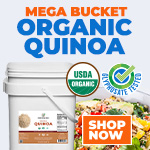Shortcuts can kill: Learn how to can food correctly for healthy, long-term food storage
Monday, December 21, 2015 by: Daniel Barker
Tags: canning tips, healthy eating, food safety

(NaturalNews) Learning how to can foods is one of the foundations of prepping, but care must be taken during the process because improperly canned foods can cost you your life. Quite simply, when it comes to canning, there are no shortcuts.
If you don't think improper canning can be dangerous, you haven't heard Mike O'Connell's story.
O'Connell, an attorney from Washington State, was recently admitted to the hospital with symptoms that resembled a stroke: dizziness, double vision and difficulty standing up.
Tests came back negative for a stroke and O'Connell was discharged. However, over the next 48 hours, his condition worsened; his speech became slurred, his eyelids drooped and he began having trouble swallowing. O'Connell had also become extremely weak and his breathing was shallow.
Diagnosis: botulism from improper canning method
A friend, who was a neurosurgeon, gave his daughter a checklist to try to pinpoint what might be causing these drastic health changes. When O'Connell returned to the hospital and the doctors re-examined him, it was determined that he was suffering from the a food-borne illness, botulism -- something that was indeed on the checklist.It turns out that O'Connell became ill from eating some elk meat that he had canned improperly about one week before the incident. During the canning process, he used a pressure cooker that was too small, jam-packing it with a great deal of meat. Additionally, the method he referred to was from an old family recipe. He also decided to take some shortcuts. For example, he improperly handled a jar that had lost its seal, deciding to refrigerate it and then eat from it the next day. All of this resulted in a case of botulism which nearly killed him.
O'Connell may be alive, but he's also paralyzed from the experience. Since the illness, he has undergone extensive rehabilitation, but he still walks with a cane and has lost his sense of taste, which he may never recover.
Canning shortcuts can put you on fast-track to illness
Daisy Luther recounts O'Connell's story on her blog, which appeared on The Organic Prepper. Her goal was to illustrate the importance of proper techniques when canning food.She relates the opinions of those who believe that modern canning techniques are unnecessary, and attempts to put the common belief that people don't get sick from canned food to rest.
"So you know those people who say, 'I've never heard of anyone getting botulism from home-canned food. That's just a scare tactic from the USDA.' Well, you can tell them about Mr. O'Connell," Luther writes, "who still hasn't fully recovered from his bout with unsafely preserved food. In fact, he may never completely recover."
As Luther notes, canning is an age-old and highly-effective method of preserving foods, but there is no reason to discount the recent advances in the science of canning -- namely, the use of pressure canners as well as water bath canners.
Canning is a great way to make sure your family will have delicious and healthy homemade food year-round, or in the event of a prolonged disaster scenario.
Helpful tips for safe canning
Several online resources exist to learn more about safe canning, but perhaps one of the more extensive ones is PickYourOwn.org, which has a great deal of information about how to can just about any food imaginable.Here a just a few helpful tips from a specific section of that site:
Don't use canning recipes prior to 1990
The methods -- and the safety inherent in those methods -- have changed through the years. Back then, most food was canned without processing, so food was more prone to spoilage and apt to lead to food poisoning.
Use only two types of canners
Boiling-water canners and pressure canners are ideal. They manage heat and pressure significantly better than other types.
Know your temperatures
For example, 240 - 250 degrees Fahrenheit (under pressure) is best for meat, poultry and low-acid vegetables like green beans. Stay away from temperatures the are between 40 - 140 degrees Fahrenheit as that range promotes very fast growth of mold and bacteria.
There's no need to be afraid of home canning. Done properly, canning is a safe and practical method of preserving foods. Just keep in mind the cardinal rule: there are no shortcuts!
Sources:
http://www.theorganicprepper.ca
http://www.pickyourown.org/preppers_canning.php
http://www.pickyourown.org/canning_whyuseacanner.htm
Canning tips at FETCH.news
Get independent news alerts on natural cures, food lab tests, cannabis medicine, science, robotics, drones, privacy and more.
Take Action: Support Natural News by linking to this article from your website
Permalink to this article:
Embed article link: (copy HTML code below):
Reprinting this article:
Non-commercial use OK, cite NaturalNews.com with clickable link.
Follow Natural News on Facebook, Twitter, Google Plus, and Pinterest
- Newly released JFK files reveal Pentagon's role in creating Lyme disease and covid in the same lab
- Trump nominates VACCINE ZEALOT Susan Monarez to lead the CDC, sidelining RFK Jr.'s reform efforts
- Obama accused of laundering USAID funds to fuel global protest movements, regime change operations
- HUGE: Putin claims 2020 election fraud in U.S. sparked Ukraine war, calls for peace talks with Trump
- Chris Rufo finally reveals abuse liberals unleashed on his wife and young kids...
- Deep State in disarray: Trump's funding freeze sows chaos, Democrats vow legal battle
- Trump shows his true colors
- STARDUST, a secretive Israeli-US startup, plans risky solar geoengineering experiment to BLOCK OUT THE SUN
- $2B Roundup verdict: A landmark blow to Bayer and a win for health freedom
- Trump's greatest betrayal so far: Accelerating Middle East wars, silencing dissent, and serving Zionist masters
- Outrageous government fraud: $312M in COVID loans went to children as young as 9 months old
- Festive flavors: The sweet history, nutritional profile and health benefits of pecan pie
- Elon Musk: Aliens could be here on Earth RIGHT NOW
- SWEET SABOTAGE: CIA's secret war on Soviet sugar revealed in JFK files
- Dr. Mike Yeadon releases 15-minute testimony - WATCH - about genocidal intent of COVID “vaccines”
- Govt. agency closed by DOGE looked like a palace inside, with oil paintings fit for a KING...
- “Behind the Green Mask”: Rosa Koire exposes the hidden agenda of UN Agenda 21
- “Forever chemicals” in drinking water drive alarming cancer surge, new study warns
- Newly released JFK files reveal Pentagon's role in creating Lyme disease and covid in the same lab
- Elon Musk: Aliens could be here on Earth RIGHT NOW
- Reclaim your health: How midlife exercise reverses years of inactivity
- Trump reverses course on Gaza plan, says “nobody is expelling Palestinians”
- EPA advisor admits the agency is funneling billions to climate groups ahead of Trump’s return to White House
- Big Pharma's $8 Billion bribery scheme exposed: how doctors are pushed to prescribe junk science, not heal
- Space war brewing? Russia threatens to destroy Starlink satellites
- A lack of integrity in Academia: Harvard professor found GUILTY of fraudulent research to promote CRT theory
- Survival 101: Effective EMF blocking techniques
- Rep. Nancy Mace introduces bill to ban biological males from female facilities on federal property
- Mike Adams Sermon 66: God will DESTROY ISRAEL for its wickedness
- Pilots report mysterious lights 'moving at extreme speeds' across Oregon skies
- 5 Simple steps to boost your brainpower: How to strengthen executive function in a distracted world
- Historian warns Israel may be entering an “IRREMEDIABLE DECLINE”
- Florida takes a stand: DeSantis proposes permanent ban on mRNA vaccine mandates
- RFK Jr.'s SSRI antidepressant investigation sparks liberal meltdown, exposes Big Pharma's dangerous game
- OpenAI whistleblower who dissented against how the company trained ChatGPT found dead
- Sugarcane extract superior to cholesterol-lowering drugs?
- EPA advisor admits the agency is funneling billions to climate groups ahead of Trump’s return to White House
- The Health Ranger releases “Vaccine Zombie” song and music video, using AI-animated zombies for the music video
- California's social media censorship law struck down: A victory for free speech or a threat to online safety?
- Dr. Mike Yeadon releases 15-minute testimony - WATCH - about genocidal intent of COVID “vaccines”
- The pandemic as a tool for INDOCTRINATION: Understanding “The Indoctrinated Brain” by Dr. Michael Nehls
- Mike Adams releases country western hit single: Goin’ Back in Time is Comin’ Home
- Mike Adams releases music poetry sensation: A Child of God
- RFK Jr. clears key hurdle: Sen. Susan Collins backs controversial HHS nominee, signaling a new era for health policy
- Florida takes a stand: DeSantis proposes permanent ban on mRNA vaccine mandates
- Unpacking the Lies That We’ve Been Fed – new song and music video released by Mike Adams, the Health Ranger
- Mike Adams releases new song and music video: Nothing More Disgusting Than a Globalist
- Congratulations to the FULLY UNVACCINATED as you resisted the COVID-19 PROPAGANDA MACHINE fueled by over $100 BILLION
- “Why we influenced the 2020 elections”: Facebook files reveal the coordinated effort to bury the Hunter Biden laptop story
- Michigan sheriff announces criminal investigation into 2020 election crimes, Dominion Voting Systems
- Israeli soldiers accused of even more torture and abuse in the West Bank
- Migrants are taking advantage of recent hurricanes to scam residents and loot their homes
- House Intelligence Committee calls for the ARREST and PROSECUTION of Dr. Anthony Fauci
- Peter Rost exposes Big Pharma corruption in his book “The Whistleblower: Confessions of a Healthcare Hitman”
- Red Cross issues warning to stop blood plasma donations from vaccinated people
- Scientists confirm: GENIUS brain function can be spontaneously unleashed in humans without any apparent cause
- EPA advisor admits the agency is funneling billions to climate groups ahead of Trump’s return to White House
- HYSSOP: What research reveals about the health benefits of this ancient holy herb
- Two containers with completed ballots fall out of truck in Florida
- Fully vaccinated about to see “tsunami” of illness and death, warns virologist
- Global leaders unite to clamp down on “misinformation” with UN-backed Cascais Declaration
- BREAKING: 2025 NDAA authorizes mandatory military draft of WOMEN across America… as Pentagon pursues global NUCLEAR war with both Russia and China at the same time
- Michael Yon warns of a ZIONIST TAKEOVER in Trump’s second administration
- BOMBSHELL: DNA testing kits are a SCAM to develop ethnic-specific bioweapons
- Ozempic and Wegovy weight loss drugs are injectable LIZARD VENOM PEPTIDES that may unleash a devastating wave of organ failure… side effects align with symptoms of SNAKE BITES
- Israeli soldiers accused of even more torture and abuse in the West Bank
- These 13 countries just signed an agreement to engineer a global FAMINE by destroying food supply
- NASA admits that climate change occurs because of changes in Earth’s solar orbit, and NOT because of SUVs and fossil fuels
- RFK Jr. clears key hurdle: Sen. Susan Collins backs controversial HHS nominee, signaling a new era for health policy
- Sermon 30: How Jesus reveals Caesar’s FAKE CURRENCY and FALSE AUTHORITY
- Coriander seeds: Ancient medicine backed by modern science
- Arizona officials claim Maricopa County needs 10-13 days to tabulate results of the election
Science News & Studies
Medicine News and Information
Food News & Studies
Health News & Studies
Herbs News & Information
Pollution News & Studies
Cancer News & Studies
Climate News & Studies
Survival News & Information
Gear News & Information
News covering technology, stocks, hackers, and more



"Big Tech and mainstream media are constantly trying to silence the independent voices that dare to bring you the truth about toxic food ingredients, dangerous medications and the failed, fraudulent science of the profit-driven medical establishment.
Email is one of the best ways to make sure you stay informed, without the censorship of the tech giants (Google, Apple, Facebook, Twitter, YouTube, etc.). Stay informed and you'll even likely learn information that may help save your own life."
–The Health Ranger, Mike Adams












































